2022 HYUNDAI ELANTRA HYBRID engine coolant
[x] Cancel search: engine coolantPage 429 of 529
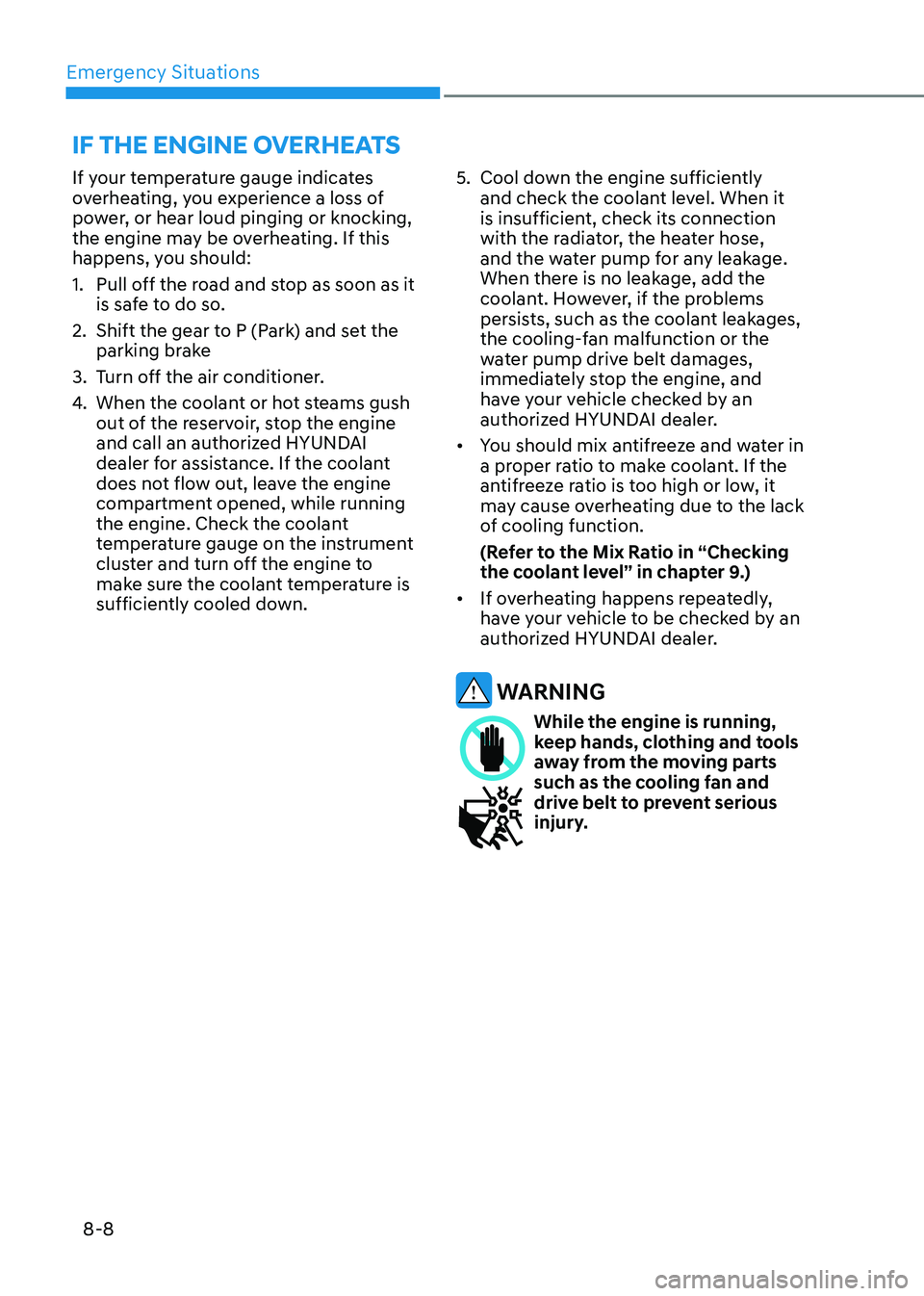
Emergency Situations
8-8
If your temperature gauge indicates
overheating, you experience a loss of
power, or hear loud pinging or knocking,
the engine may be overheating. If this
happens, you should:
1. Pull off the road and stop as soon as it
is safe to do so.
2. Shift the gear to P (Park) and set the parking brake
3. Turn off the air conditioner.
4. When the coolant or hot steams gush
out of the reservoir, stop the engine
and call an authorized HYUNDAI
dealer for assistance. If the coolant
does not flow out, leave the engine
compartment opened, while running
the engine. Check the coolant
temperature gauge on the instrument
cluster and turn off the engine to
make sure the coolant temperature is
sufficiently cooled down. 5. Cool down the engine sufficiently
and check the coolant level. When it
is insufficient, check its connection
with the radiator, the heater hose,
and the water pump for any leakage.
When there is no leakage, add the
coolant. However, if the problems
persists, such as the coolant leakages,
the cooling-fan malfunction or the
water pump drive belt damages,
immediately stop the engine, and
have your vehicle checked by an
authorized HYUNDAI dealer.
• You should mix antifreeze and water in
a proper ratio to make coolant. If the
antifreeze ratio is too high or low, it
may cause overheating due to the lack
of cooling function.
(Refer to the Mix Ratio in “Checking
the coolant level” in chapter 9.)
• If overheating happens repeatedly,
have your vehicle to be checked by an
authorized HYUNDAI dealer.
WARNING
While the engine is running,
keep hands, clothing and tools
away from the moving parts
such as the cooling fan and
drive belt to prevent serious
injury.
iF tHe engine overHeats
Page 430 of 529
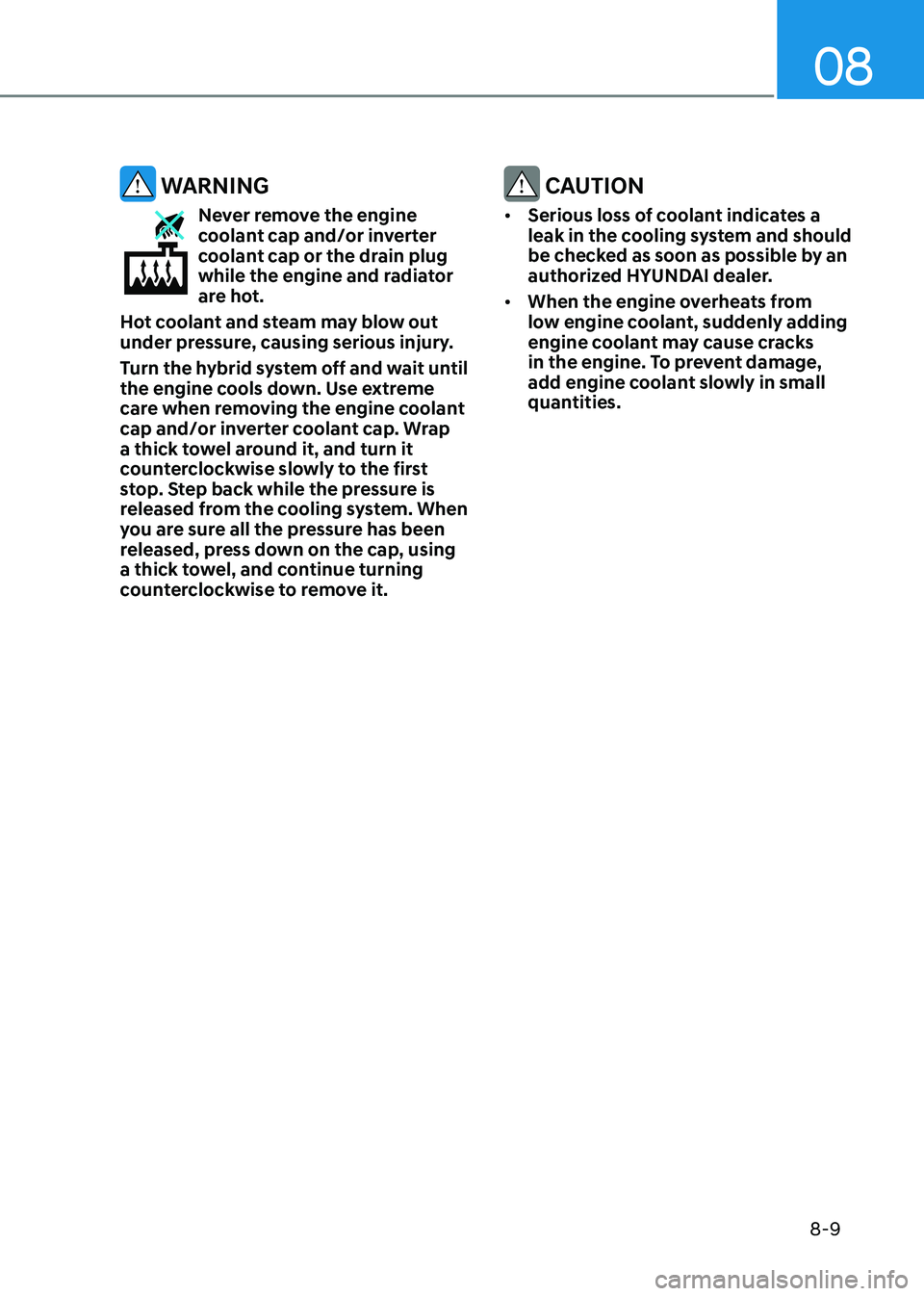
08
8-9
WARNING
Never remove the engine
coolant cap and/or inverter
coolant cap or the drain plug
while the engine and radiator
are hot.
Hot coolant and steam may blow out
under pressure, causing serious injury.
Turn the hybrid system off and wait until
the engine cools down. Use extreme
care when removing the engine coolant
cap and/or inverter coolant cap. Wrap
a thick towel around it, and turn it
counterclockwise slowly to the first
stop. Step back while the pressure is
released from the cooling system. When
you are sure all the pressure has been
released, press down on the cap, using
a thick towel, and continue turning
counterclockwise to remove it.
CAUTION
• Serious loss of coolant indicates a
leak in the cooling system and should
be checked as soon as possible by an
authorized HYUNDAI dealer.
• When the engine overheats from
low engine coolant, suddenly adding
engine coolant may cause cracks
in the engine. To prevent damage,
add engine coolant slowly in small
quantities.
Page 448 of 529
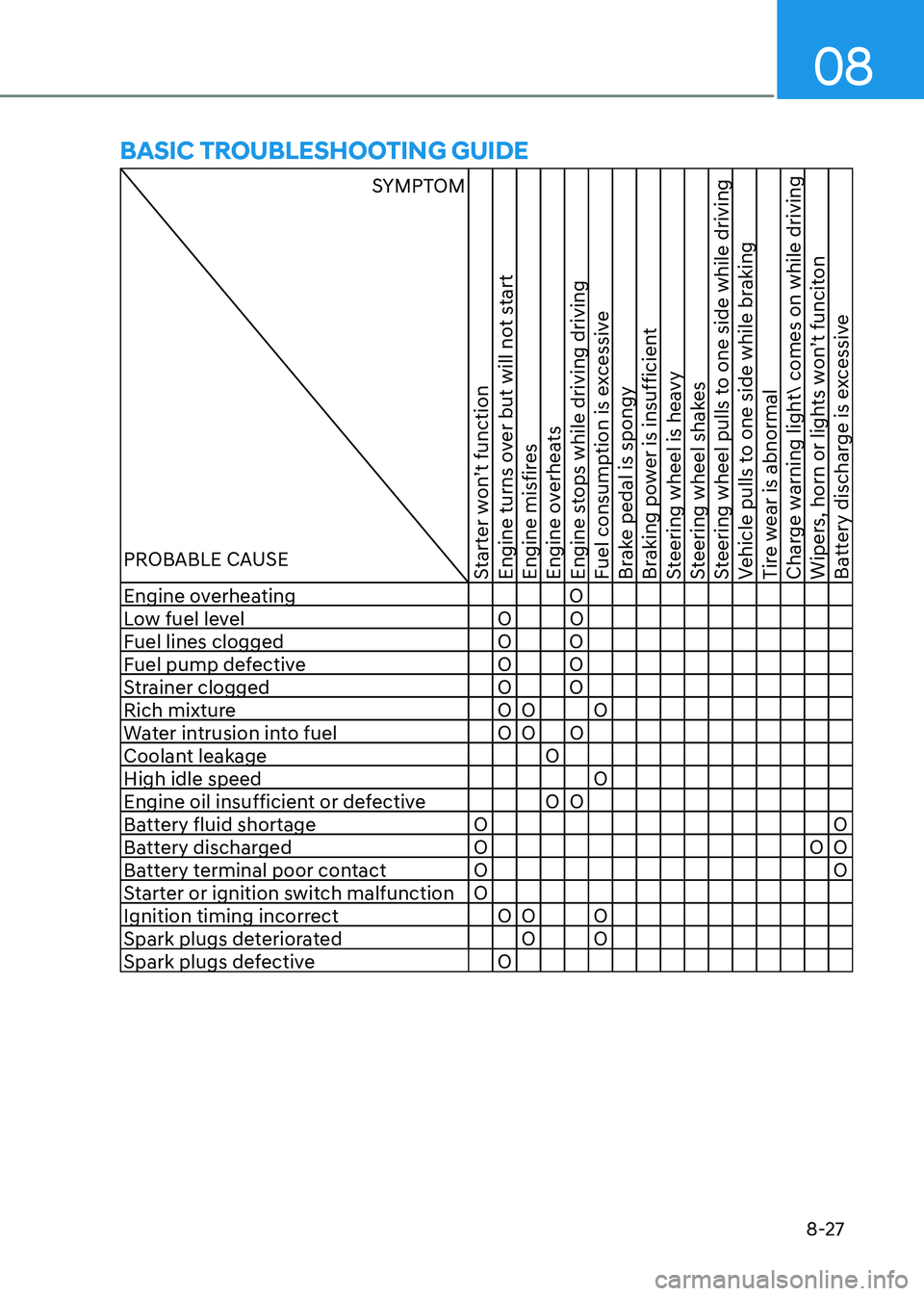
08
8-27
BasiC troUBlesHooting gUide
SYMPTOM
PROBABLE CAUSE
Starter won’t function
Engine turns over but will not start
Engine misfires
Engine overheats
Engine stops while driving driving
Fuel consumption is excessive
Brake pedal is spongy
Braking power is insufficient
Steering wheel is heavy
Steering wheel shakes
Steering wheel pulls to one side while driving
Vehicle pulls to one side while braking
Tire wear is abnormal
Charge warning light comes on while driving
Wipers, horn or lights won’t funciton
Battery discharge is excessive
Engine overheating O
Low fuel level O O
Fuel lines clogged O O
Fuel pump defective O O
Strainer clogged O O
Rich mixture O O O Water intrusion into fuel O O O
Coolant leakage OHigh idle speed O
Engine oil insufficient or defective O O
Battery fluid shortage O O
Battery discharged O O O
Battery terminal poor contact O O
Starter or ignition switch malfunction O
Ignition timing incorrect O O O Spark plugs deteriorated O O Spark plugs defective O
Page 450 of 529
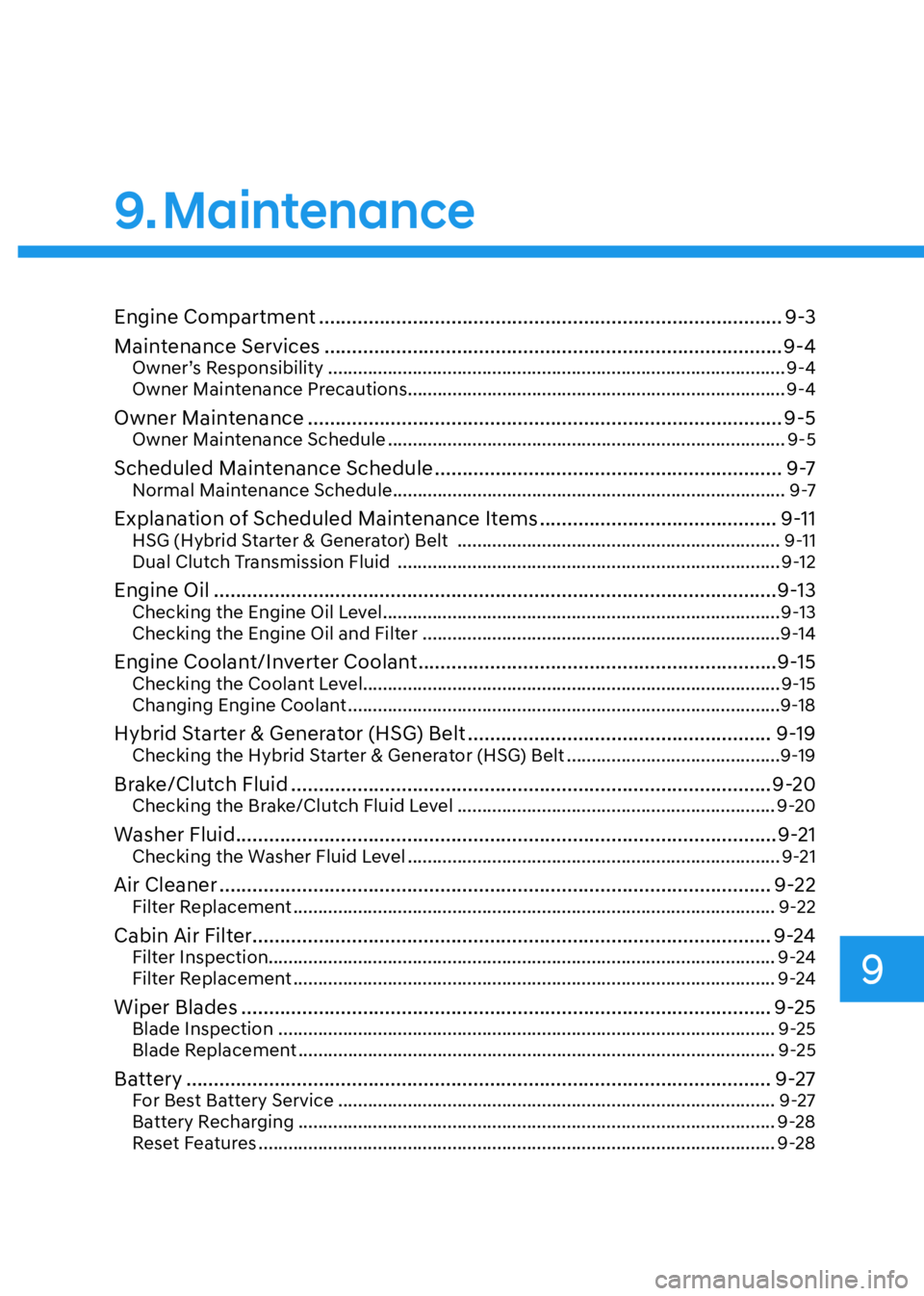
Engine Compartment .................................................................................... 9-3
Maintenance Services ...................................................................................9-4Owner’s Responsibility ............................................................................................ 9-4
Owner Maintenance Precautions ............................................................................ 9-4
Owner Maintenance ...................................................................................... 9-5 Owner Maintenance Schedule ................................................................................ 9-5
Scheduled Maintenance Schedule ............................................................... 9-7 Normal Maintenance Schedule ............................................................................... 9-7
Explanation of Scheduled Maintenance Items ........................................... 9-11 HSG (Hybrid Starter & Generator) Belt ................................................................. 9-11
Dual Clutch Transmission Fluid ............................................................................. 9-12
Engine Oil ......................................................................................................9-13 Checking the Engine Oil Level ................................................................................9-13
Checking the Engine Oil and Filter ........................................................................9-14
Engine Coolant/Inverter Coolant .................................................................9-15 Checking the Coolant Level.................................................................................... 9-15
Changing Engine Coolant .......................................................................................9-18
Hybrid Starter & Generator (HSG) Belt ....................................................... 9-19 Checking the Hybrid Starter & Generator (HSG) Belt ...........................................9-19
Brake/Clutch Fluid ....................................................................................... 9-20 Checking the Brake/Clutch Fluid Level ................................................................ 9-20
Washer Fluid ..................................................................................................9-21 Checking the Washer Fluid Level ........................................................................... 9-21
Air Cleaner .................................................................................................... 9-22 Filter Replacement ................................................................................................. 9-22
Cabin Air Filter .............................................................................................. 9-24 Filter Inspection...................................................................................................... 9-24
Filter Replacement ................................................................................................. 9-24
Wiper Blades ................................................................................................ 9-25 Blade Inspection .................................................................................................... 9-25
Blade Replacement ................................................................................................ 9-25
Battery .......................................................................................................... 9-27 For Best Battery Service ........................................................................................ 9-27
Battery Recharging ................................................................................................ 9-28
Reset Features ........................................................................................................ 9-28
9. Maintenance
9
Page 452 of 529
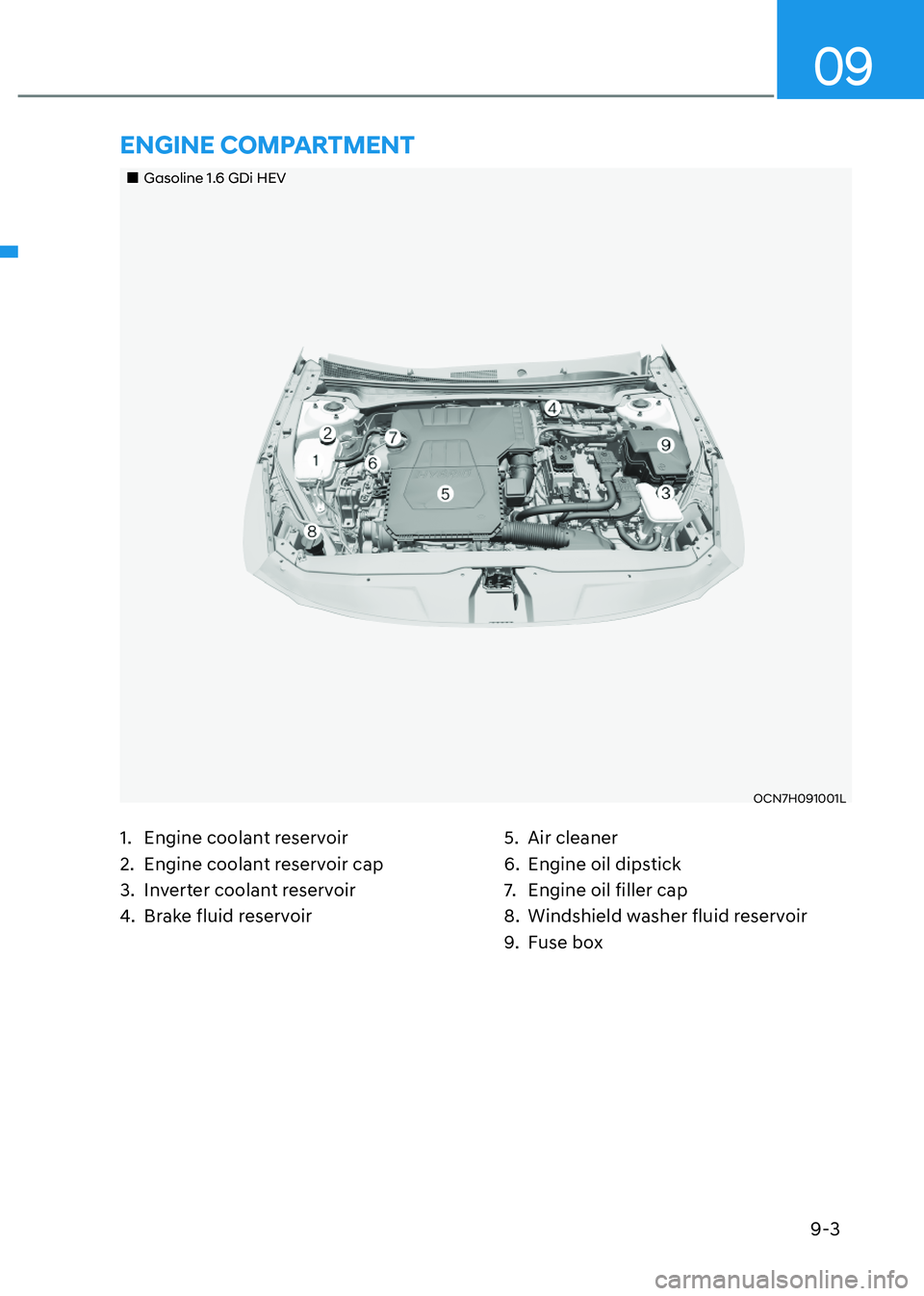
9-3
09
1. Engine coolant reservoir
2. Engine coolant reservoir cap
3. Inverter coolant reservoir
4. Brake fluid reservoir5. Air cleaner
6. Engine oil dipstick
7. Engine oil filler cap
8. Windshield washer fluid reservoir
9. Fuse box
ENGINE COMPARTMENT
Gasoline 1.6 GDi HEVGasoline 1.6 GDi HEV
OCN7H091001LOCN7H091001L
Page 457 of 529
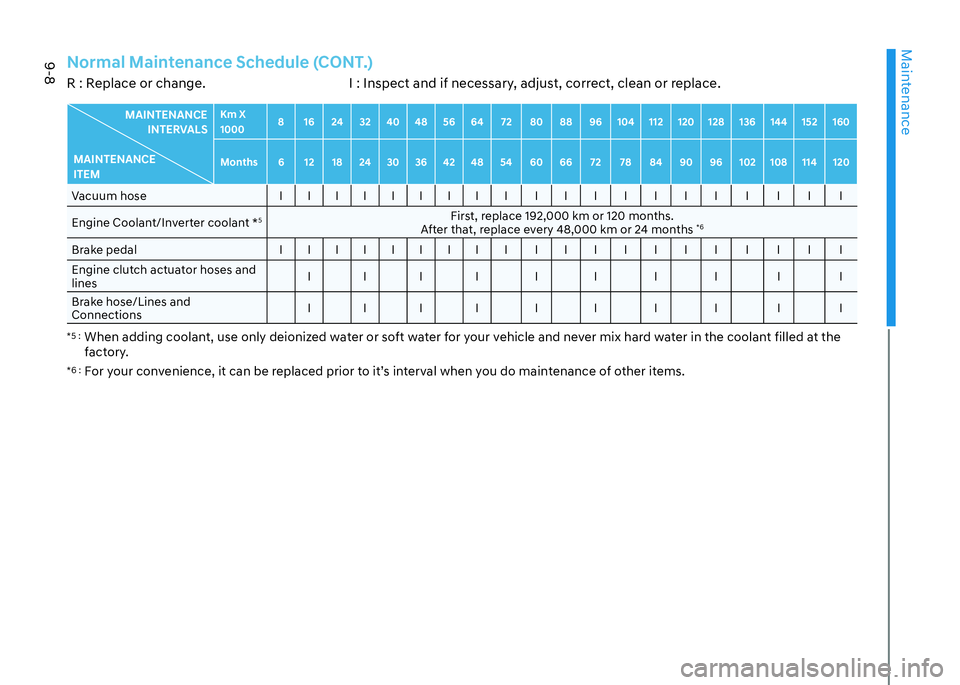
Maintenance
9-8
Normal Maintenance Schedule (CONT.)R : Replace or change. I : Inspect and if necessary, adjust, correct, clean or replace.
MAINTENANCE INTERVALS
MAINTENANCE ITEM Km X 1000
8 16 24 32 40 48 56 64 72 80 88 96 104 112 120 128 136 144 152 160
Months 6 12 18 24 30 36 42 48 54 60 66 72 78 84 90 96 102 108 114 120
Vacuum hose I I I I I I I I I I I I I I I I I I I I
Engine Coolant/Inverter coolant * 5
First, replace 192,000 km or 120 months.
After that, replace every 48,000 km or 24 months *6
Brake pedal I I I I I I I I I I I I I I I I I I I I
Engine clutch actuator hoses and lines IIII I I I I I I
Brake hose/Lines and Connections IIII I I I I I I
*5 : When adding coolant, use only deionized water or soft water for your vehicle and never mix hard water in the coolant filled at the
factory.
*6 : For your convenience, it can be replaced prior to it’s interval when you do maintenance of other items.
Page 460 of 529

09
9-11
Engine Oil and Filter
The engine oil and filter should be
changed at the intervals specified in the
maintenance schedule.
Drive Belts
Inspect all drive belts for evidence
of cuts, cracks, excessive wear or oil
saturation and replace if necessary. Drive
belts should be checked periodically
for proper tension and adjusted as
necessary.
Information
When you are inspecting the belt, turn the engine off.
Fuel Lines, Fuel Hoses and Connections
Check the fuel lines, fuel hoses and
connections for leakage and damage.
Have an authorized HYUNDAI dealer
replace any damaged or leaking parts
immediately.
HSG (Hybrid Starter & Generator) Belt
The HSG belt should be changed at the
intervals specified in the maintenance schedule.
Fuel Filter
A clogged-up fuel filter may limit the
vehicle driving speed, damage the
emission system, and cause the hard
starting. When a considerable amount
of foreign substances are accumulated
in the fuel tank, the fuel filter should be
replaced.
Upon installing a new fuel filter, operate
the engine for several minutes, and
check the connections for any leakages.
Fuel filters should be installed by an
authorized HYUNDAI dealer.
Vapor Hose and Fuel Filler Cap
The vapor hose and fuel filler cap should
be inspected at those intervals specified
in the maintenance schedule. Make sure
a new vapor hose or fuel filler cap is
correctly replaced.
Air Cleaner Filter
A genuine HYUNDAI air cleaner filter
is recommended when the filter is
replaced.
Spark Plugs
Make sure to install new spark plugs of
the correct heat range.
Cooling System
Check cooling system components, such
as radiator, coolant reservoir, hoses and
connections for leakage and damage.
Replace any damaged parts.
EXPLANATION OF SCHEDULED MAINTENANCE ITEMS
Page 461 of 529
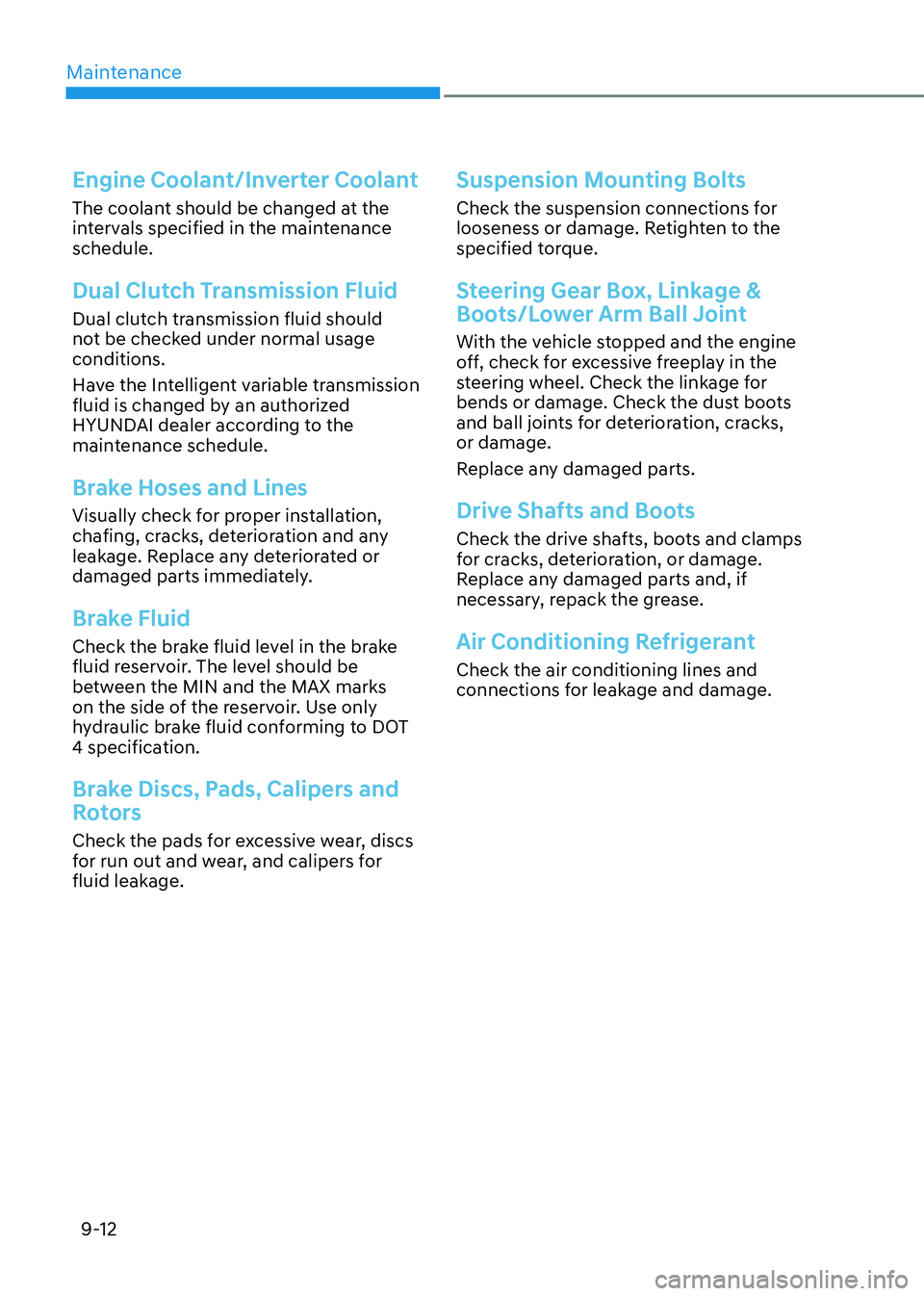
Maintenance
9-12
Engine Coolant/Inverter Coolant
The coolant should be changed at the
intervals specified in the maintenance schedule.
Dual Clutch Transmission Fluid
Dual clutch transmission fluid should
not be checked under normal usage conditions.
Have the Intelligent variable transmission
fluid is changed by an authorized
HYUNDAI dealer according to the
maintenance schedule.
Brake Hoses and Lines
Visually check for proper installation,
chafing, cracks, deterioration and any
leakage. Replace any deteriorated or
damaged parts immediately.
Brake Fluid
Check the brake fluid level in the brake
fluid reservoir. The level should be
between the MIN and the MAX marks
on the side of the reservoir. Use only
hydraulic brake fluid conforming to DOT
4 specification.
Brake Discs, Pads, Calipers and
Rotors
Check the pads for excessive wear, discs
for run out and wear, and calipers for
fluid leakage.
Suspension Mounting Bolts
Check the suspension connections for
looseness or damage. Retighten to the
specified torque.
Steering Gear Box, Linkage &
Boots/Lower Arm Ball Joint
With the vehicle stopped and the engine
off, check for excessive freeplay in the
steering wheel. Check the linkage for
bends or damage. Check the dust boots
and ball joints for deterioration, cracks, or damage.
Replace any damaged parts.
Drive Shafts and Boots
Check the drive shafts, boots and clamps
for cracks, deterioration, or damage.
Replace any damaged parts and, if
necessary, repack the grease.
Air Conditioning Refrigerant
Check the air conditioning lines and
connections for leakage and damage.